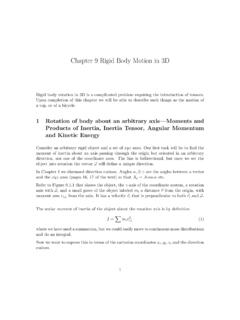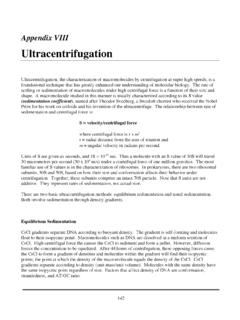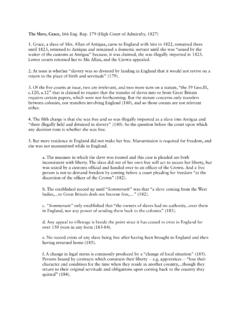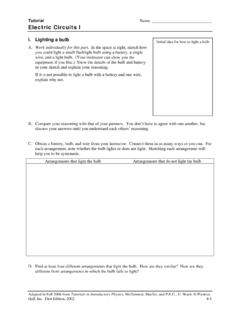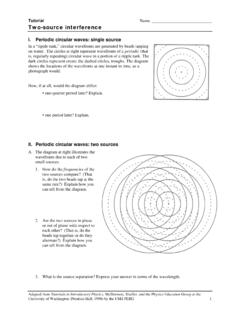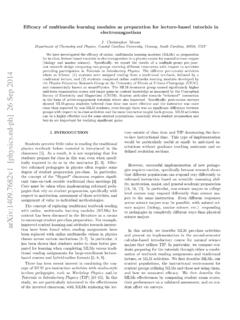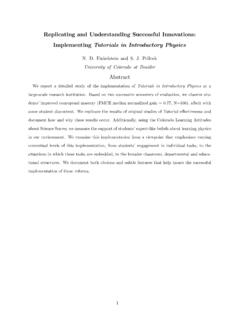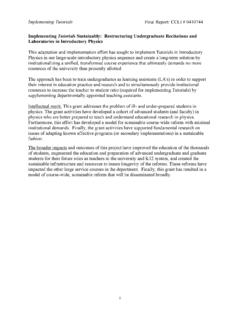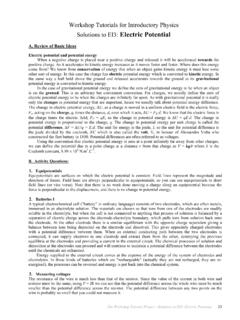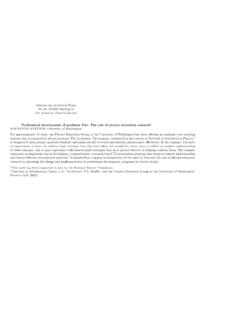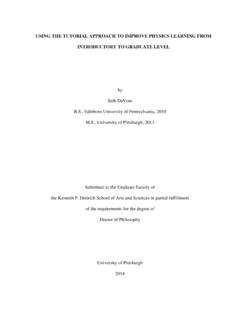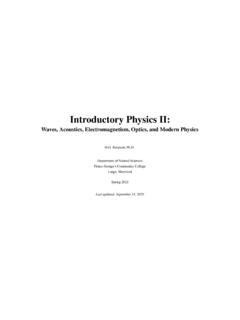Transcription of Implementing Tutorials in Introductory Physics at …
1 Implementing Tutorials in Introductory Physics at an Inner-City University in Chicago [1] Mel S. Sabella Department of Chemistry and Physics , Chicago State University 773-995-2172 Tutorials in Introductory Physics [2] are widely used and have proven to be effective in promoting student understanding for many students in Introductory Physics . Despite this, there are currently few research results that document their effectiveness at inner-city schools in which students may have weak preparation in mathematics and reading. In this paper we discuss our preliminary efforts in Implementing and evaluating the effectiveness of these materials for students at an inner-city university located on the south side of Chicago. Introduction There are currently a number of Physics curricula that have proven to be effective in promoting student understanding. The Physics Education Group at the University of Washington has developed one such curriculum, Tutorials in Introductory Physics .
2 Most of the research associated with this material focuses on student performance in the calculus-based Introductory Physics class at traditional universities. During the Fall 2001 and Spring 2002 semester we implemented the Tutorials in the algebra-based and calculus-based Introductory Physics classes at Chicago State University (CSU). CSU is a comprehensive university located on Chicago s south side. The school s makeup is 90% African American, 5 % White, 4 % Hispanic, and 1 % Asian. Most students who attend CSU reside within 5 miles of the campus and have attended public high schools on the south side of Chicago. Many of the students at CSU are the first generation in their families to attend college and over 50 % of the students have at least one child [3]. In the fall 2001 semester, we implemented a slightly modified set of Tutorials in the algebra-based Physics class at CSU.
3 The implementation of this curriculum highlighted the fact that many students at CSU may not possess the necessary math and reading background to accomplish some of the goals of the tutorial curriculum. During the past academic year we utilized a number of research methods to evaluate the effectiveness of this curriculum with the population of students in two classes at CSU [4]. We pilot-tested the Tutorials in the algebra-based (Phys 151) and the calculus-based (Phys 211) Physics classes. Both courses focused on mechanics and mechanical waves. In the 151 class, students also studied topics in thermodynamics. The course schedule divides the seven contact hours into three hours of lecture, one hour of recitation, and three hours of laboratory. Faculty members at CSU have a lot of freedom in teaching these courses.
4 This allowed us to include two hours/week of Tutorials in the 151 and 211 classes. Method and Results In order to evaluate the effectiveness of the tutorial curriculum with the students at CSU we employed three main research tools. The Force Concept Inventory (FCI) [5] was used to pre and post-test students on their overall force concept. In addition to the FCI, open-ended pretests and post-tests were used to provide us with a deeper probe into student understanding [6]. We also conducted interviews with students on a specific topic addressed in the Tutorials . Upon completion of the course, students in the algebra-based and calculus-based courses had modest gains on the FCI [7]. The results on the FCI are included in Table 1. The table also shows that there was little difference in performance between students who went through the tutorial curriculum and students who went through a more traditional course at CSU.
5 To complement the results from the FCI, we asked open-ended questions throughout the course. Students participated in weekly pretests that were typically given after lecture instruction, but before students were engaged in the tutorial material. All pretests were open-ended and asked students to explain the reasoning behind their answers. As an instructional tool, the pretests force students to commit to an answer on their own before being involved in group work. As a research tool, they provide instructors and researchers with a detailed picture of student understanding on a wide range of topics. Pretests place instructors in a good position to address student difficulties and build on student strengths. Open-ended questions on exams served as the post-tests. Often, the post-test questions were conceptual and required students to explain how they came up with their answers. In this paper, we focus on a single topic, acceleration in one-dimension (A1D) [8].
6 In the 151 class, a slightly modified version of the A1D tutorial was used to fit an interactive lecture setting. The 211 class used the A1D tutorial from the Tutorial workbook. Pretest Figure 1 shows the pretest for the A1D tutorial. This pretest was given after lecture instruction in both the 151 and 211 classes. (All questions in this paper have been paraphrased.) A correct solution to this problem would involve the students sketching velocity vectors which decrease on the way up the ramp and increase on the way down the ramp. Students must then recognize that since the change in velocity is always directed down the ramp the acceleration is also down the ramp for the entire motion of the ball. Responses on the pretest indicated that students had a difficult time determining the direction of the acceleration vector.
7 The majority of the students drew acceleration vectors in the direction of the velocity. Table 2 shows the distribution of responses on this question for an instant during the time the ball rolls up the incline, the instant when the ball reaches the top of the incline, and an instant during the time the ball rolls down the incline. Because performance was so similar in the 151 and the 211 classes, the results are combined. None of the students in either class provided correct explanations for their answers. Post-test In the tutorial, students first construct change in velocity vectors in order to describe the Figure 1: A1D Pretest The diagram represents a strobe photograph of the motion of a ball as it rolls up and then down a track. Draw a vector to represent (1) the velocity of the ball and (2) the acceleration of the ball. Table 1: FCI results at CSU Phys 151 Tutorials (N = 20) Phys 211 Tutorials (N = 7) Phys 211 No Tutorials (N = 11) Pre 20 % 23 % 21 % Post 30 % 43 % 37 % Gain.
8 12 .26 .21 all students are matched Table 2: Responses on A1D Pretest (N=28) Correct zero other Uphill 18 % 57 % 0 % 25 % Top 0 % 0 % 50 % 50 % Downhill 79 % 7 % 0 % 14 % Uphill Downhill acceleration of the ball. For the most part, students were able to draw correct velocity vectors for the ball as it rolled along the ramp on the pretest. In the tutorial, this student strength is used to aid students in developing an understanding of acceleration. The post-test given to students in both classes involved a similar context to the pretest and the A1D tutorial. The question was asked on the first exam in Physics 151 and on the final exam in Physics 211. The question involves a ball rolling along three sections of a track. The ball first rolls down a ramp, then along a horizontal portion, and finally up a ramp. Performance on this question showed that after being engaged in the tutorial curriculum most students were able to recognize the differences between the velocity and the acceleration vectors.
9 Table 3 shows the results of the post-test in the 151 and 211 classes. On this question 61 % of the students answered correctly in the algebra-based course and 88 % of the students answered correctly in the calculus-based course. Student explanations showed that they were able to recognize when the acceleration vector is zero, when it is in the same direction as the velocity and when it is in the opposite direction as the velocity. In the Physics 211 class we also gave a question testing the same concept on the first exam. Students were shown vectors representing an object s velocity at five successive times. The velocity vectors decreased in magnitude for each successive time. One part of this question is shown in Figure 2. Students were asked to sketch an acceleration vector for the object s motion at specific instants. On this question, 89 % of the students recognized that the object was slowing down and that the acceleration vectors had to be directed opposite to the velocity vectors.
10 We administered a similar question involving a ball rolling up and down an incline on the final exam in the Physics 211 class without Tutorials . The question showed a strobe photograph of a ball rolling up and down an incline, similar to the question posed on the pretest. About 12 % of the students in this class responded correctly. Because the instructor in this class did not cover strobe photographs, the question was administered again, without the strobe representation to the same students on the first exam during the following semester. Despite the fact that these students had seen a very similar question on their final the previous semester, only 18 % of the students answered correctly. Discussion These results suggest that the activities in the tutorial were very helpful in guiding students toward an understanding of the concept of acceleration.
